Seasonic Platinum SS-1050XP3 & SS-1200XP3 Power Supply Review
by E. Fylladitakis on September 3, 2014 6:00 PM EST- Posted in
- Cases/Cooling/PSUs
- Seasonic
- 1200W
- 80Plus Platinum
- 1050W
Seasonic Platinum SS-1200XP3 Cold Test Results
This is a repeat (in case you skipped page three), but for the testing of PSUs, we use high precision electronic loads with a maximum power draw of 2700 Watts, a Rigol DS5042M 40 MHz oscilloscope, an Extech 380803 power analyzer, two high precision UNI-T UT-325 digital thermometers, an Extech HD600 SPL meter, a self-designed hotbox, and various other bits and parts. For a thorough explanation of our testing methodology and more details on our equipment, please refer to our How We Test PSUs - 2014 Pipeline post.
The energy conversion efficiency of the Seasonic Platinum SS-1200XP3 is, unexpectedly, noticeably better than that of its 1050W sibling. Once again, the maximum conversion efficiency manifests at 40% load (94.4%), with an average conversion efficiency within the nominal load range (20% to 100%) of 93.4%. From the chart, we can see that the Platinum SS-1200XP3 easily surpasses the 80 Plus Platinum efficiency requirements during our testing. At 10% load, the efficiency drop to 89.5% is very small, but at just 5% load it drops to 79.8%. Obviously using a 1200W PSU to drive a 60W load on a regular basis would be rather odd, so in most use cases the efficiency will be much higher.
Much like its less powerful sibling, the cooling profile of the Seasonic Platinum SS-1200XP3 is very aggressive, even with the fan set to hybrid mode. Even at room temperature, the fan starts at just 20% load. This time however, the Platinum SS-1200XP3 maintains very low noise levels up to 40% load, taking advantage of its very high efficiency. As the load increases above 50%, the speed of the fan increases radically, turning the silent 80 Plus Platinum certified unit into a hoover in no time at all. The operating temperature is very low, with the heatsinks hardly surpassing 55°C at maximum load, increasing the long-term reliability of the unit.


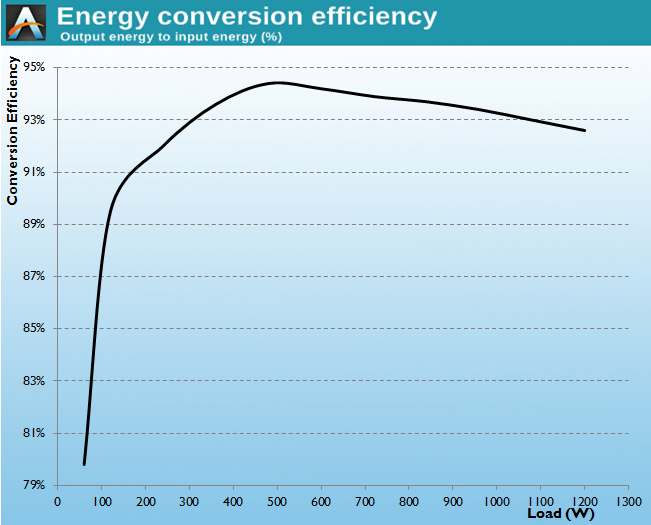
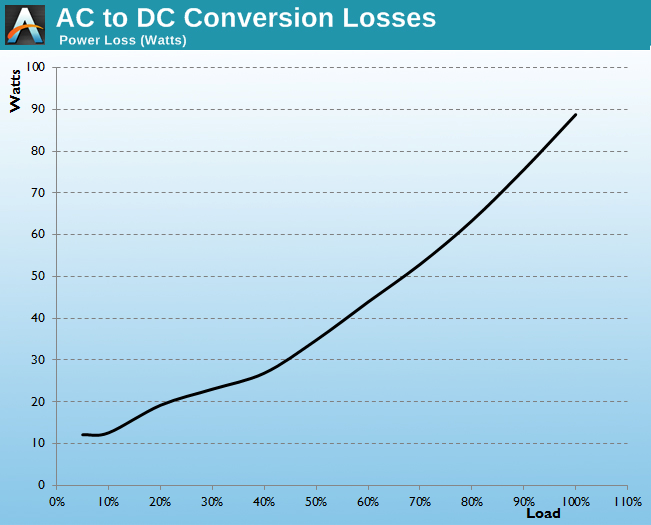
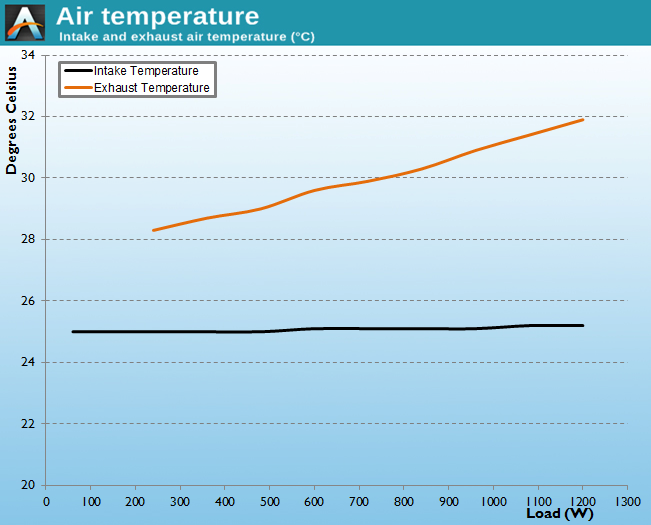
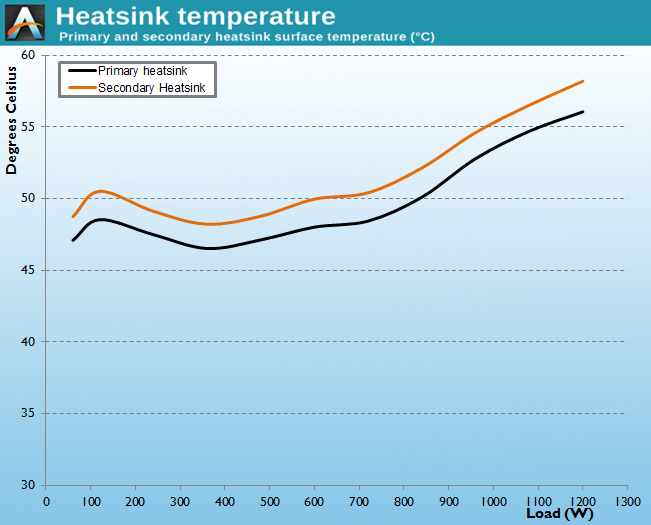
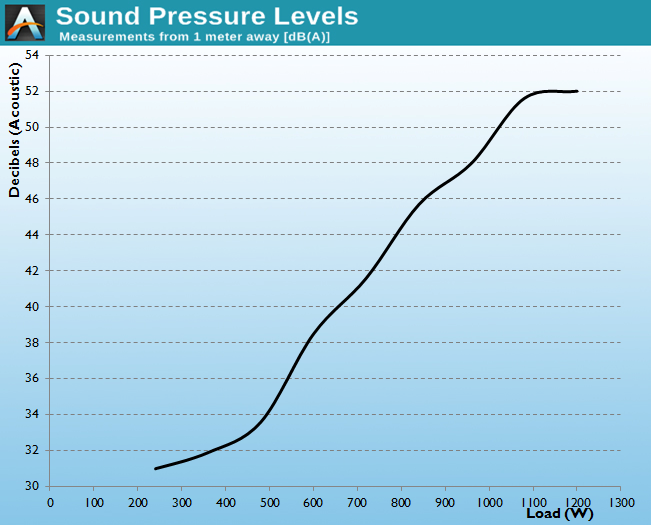








39 Comments
View All Comments
ijozic - Thursday, September 4, 2014 - link
It sounds like it would cost noticeably more for something most people PROBABLY won't really care about. And the market is already quite competitive..Samus - Thursday, September 4, 2014 - link
The only complicated factor is space inside the standard ATX housing, but considering there are 500-watt 80+ Gold SFX PSU's that are 1/3rd the size of ATX, making a 100-watt primary stage with a 1000-watt secondary stage shouldn't be impossible. The most expensive part would likely be the cap for the relay (1/4 farad) and obviously that cap is going to be pretty large, most electrolytic caps this size are around 5" long.I think the BOM would be ~$20, and engineering it in isn't rocket science. This could totally be done, and if I were paying $200+ for a PSU, I'd expect some level of engineering beyond a good bridge design and PFC.
jann5s - Thursday, September 4, 2014 - link
have a look at the pico-PSU, these go up to 160W and are approximately the size of the ATX-plug attached to the umbilical coard of your PSU, this will definately fit.DanNeely - Thursday, September 4, 2014 - link
With a picoPSU you need to look at not just the 12V to 3.3/5V (smaller models) or 19V to 12/5/3.3V circuitry on the ATX plug; but the size of the external power brick used to feed it. It's still probably feasible volumetrically, but isn't nearly as much of a gimmie as just looking at the size of the ATX plug module implies.DanNeely - Thursday, September 4, 2014 - link
... especially since this could potentially be done by beefing up the existing Vsb circuit instead of adding something entirely new. JonnyGuru's testing shows current Vsb implementations aren't particularly impressive at only around 80%; but depending on how much worse current models perform below 10% some gains might still be reasonable. With the Titanium spec mandating 90% efficiency at 10% load though I'm not sure it's really worth it. On the 300-700W units that are suitable for ~90% of enthusiast systems 10% of rated power is generally enough to cover idle loads as long as you don't do anything silly (eg running an IGP powered low power mITX board with an SLI capable PSU). OTOH idle loads are steadily improving with each new CPU/GPU generation and the 80+ group will need to extend the standard to be tougher somewhere for whatever comes after titanium.TelstarTOS - Thursday, September 4, 2014 - link
I totally agree. What's holding me to get a 1000W+ PSU is the efficiency at low loads. With CPUs getting more and more green, PSUs should do the same and not only when under full load (which is a countersense if you really think about it).DanNeely - Thursday, September 4, 2014 - link
More attention is being paid to lower end efficiency than in the past; and this PSU is a prime example. While it falls short of the (new) 90% efficient at 10% load requirement for 80+ titantium, it's ~89% efficiency is much better than any of the other PSUs reviewed earlier this year did; none of which did better than the low to mid 80's at that level.Phillip Wager - Monday, September 8, 2014 - link
i like the dual stage idea but i am assuming most consumers are not willing to pay more for additional cost/complexity because that small amount of power that you are wasting turns out to be a very small amount of money over the lifetime of the system. I am somewhat suprised with your test results with your system because my computer has nearly identical specs and i have a 600 watt power supply and i have never had so much as a hiccup. Maybe get a different device for measuring power draw or perhaps your power supply is not as inefficient as you think.bsim500 - Thursday, September 4, 2014 - link
I agree, but there's not much you can do. It's the nature of high-wattage PSU's. If they came out with a 95% efficient "super platinum" PSU, lower wattage PSU's would adopt the same technology and the "idle gap" would still remain.Personally, I have a Seasonic G360 (yes, 360W PSU) that perfectly feeds an i5 + 7870 GFX card, and pulls (measured at the wall) : 182w peak Prime + Furmark / 110-150w typical gaming load / 88w 4T Prime or X264 encode load (CPU only) and 37w idle (which falls to 26w if discrete GFX card is removed, and that's with 1600MHz Ivy Bridge idle, not 800MHz Haswell), never pulling more than 50% PSU draw even under combined synthetic CPU+GPU "power viruses", and spending 90% of its time at +90% PSU efficiency with a virtually silent fan.
That 26-37w idle wattage on these PSU's is barely 50-60% efficiency level, yet the number of people who "swear" they "need" a 1200w PSU just for a single mid-range dGPU gaming rig is quite comical. ;-)
Samus - Thursday, September 4, 2014 - link
I know, "right sizing' a PSU is something few people understand. The worst thing you could do to your wallet is spend a fortune on a 600+ watt PSU and spend another fortune paying for it to inefficiently idle over the years for that i5 with integrated graphics and a single hard disk...